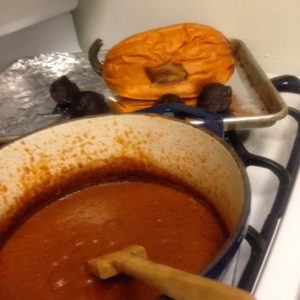This is one of the seven major Oaxacan moles. There are two main kinds, each with infinite variations. (If you ask ten Oaxacan cooks about mole amarillo, you will probably get ten quite different recipes and also realize that no one bothers to use the full name — the informal “amarillo” is enough.) One type, a dense, silky mole like a thick tomato sauce, usually functions as a filling. The other is thinned to any consistency between a heavy batter and a soup, and serves as the basis of stews and braised meat dishes. Actually, amarillo is not the only mole to be made with a lot of gradations between thick and thin. As you work with all these sauces I hope you will learn to experiment with consistency — Oaxacan cooks usually start with a thick paste as the basis of a mole and thin it more or less, depending on the purpose.
The sauce won’t really be yellow. It comes out more of an orange shade and then the green tomato dilutes the color a little. It is light, tart and refreshing. The chile amarillo or chilcosle give a yellower color and were once common in this dish. But today I find most people using the fleshier, darker guajillos.

Yellow Mole (Mole Amarillo)
Ingredients
- 3 guajillo chiles tops and seeds removed
- 1 ancho chile tops and seeds removed
- 3 large tomatillos with husks
- 1 large hard green tomato
- 1 small white onion unpeeled
- 2 cloves garlic unpeeled
- 10 black peppercorns
- 8 cloves or ¼ teaspoon ground
- 2 tablespoons lard, preferably
home-rendered or vegetable oil - 1 teaspoon salt or to taste
- 2 teaspoons fresh masa or reconstituted by mixing 2 teaspoons masa harina with 2 tablespoons water
Instructions
- Wash and griddle-dry the chiles. Place in a small bowl; cover generously with boiling water and let soak for at least 20 minutes. Drain the soaked chiles and reserve.
- While the chiles soak, prepare the vegetables. Using a griddle or cast-iron skillet thoroughly heated over low heat, roast the tomatillos, green tomato, onion, and garlic. Remove each to a bowl to catch the juices as it is done and set aside.
- Grind the peppercorns and cloves together in an electric coffee or spice grinder or with a mortar and pestle. When the roasted onion, garlic, and tomato are cool enough to handle, peel them over the bowl to catch the juices. Place the vegetables in a blender with the drained chiles and ground spices. Process to a smooth purée (about 3 minutes on high). With a wooden spoon or pusher, force the purée through a medium-mesh sieve into a bowl.
- In a medium-size saucepan, heat the lard over medium heat until rippling. Add the puréed sauce and cook, covered, for 10 minutes, stirring occasionally. Stir in the salt.
- In a small bowl, mix the masa with ½ cup water and whisk into the sauce. Bring back to a simmer and cook, whisking constantly, until the sauce is somewhat thickened and the flavors well blended, about 15 minutes.
- The amarillo is now ready to use as a filling, a thick sauce for tamales, or an accompaniment to what strikes your fancy. Mixed with shredded chicken and folded into tortillas, it is the filling for Empanadas de Amarillo. I love it as a vibrant complement to Tamales de Chepil, or as a filling for other tamales.

